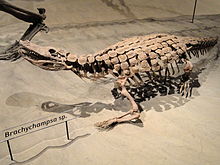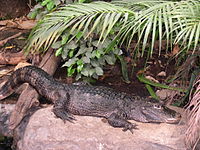Globidonta
| Globidonta Temporal range:
| |
|---|---|

| |
| Brachychampsa sp. | |
| Scientific classification | |
| Domain: | Eukaryota |
| Kingdom: | Animalia |
| Phylum: | Chordata |
| Class: | Reptilia |
| Clade: | Archosauromorpha |
| Clade: | Archosauriformes |
| Order: | Crocodilia |
| Superfamily: | Alligatoroidea |
| Clade: | Globidonta Brochu, 1999 |
| Subclades[1] | |
Globidonta is a clade of alligatoroids that includes alligators, caimans, and closely related extinct forms. It is defined as a stem-based clade including Alligator mississippiensis (the American Alligator) and all forms more closely related to it than to Diplocynodon. The group's fossil range extends back into the Campanian stage of the Late Cretaceous with early alligatoroids such as Albertochampsa and Brachychampsa.[2] Extinct globidontans were particularly common in North America and Eurasia, and their modern range also includes South America.
Basal globidontans are characterized by their blunt snouts and bulbous teeth. Modern globidontans have flattened snouts and more conical teeth, and are seen as more generalized than earlier globidontans. Generalized forms are usually expected to be ancestral to more specialized forms rather than descendants of them, so it is unusual for basal members of the group to appear specialized. This seems to conflict with the "Law of the Unspecialized" first proposed by Edward Drinker Cope in 1894. Under the Law of the Unspecialized, morphological change is always directed toward specialization, and specialized forms can never become "unspecialized" again. This pattern of change, while not seen in globidontans, can be observed in basal members of Alligatoroidea and Crocodyloidea.[3]

Flat-snouted globidontans occurred two times in the evolution of the clade: once in caimans and once in alligators. Alligator sinensis, the Chinese Alligator, has a snout that is somewhat blunt and could be considered specialized. However, its snout is not nearly as blunt as those of more basal globidontans such as Albertachampsa.[3]
If the last common ancestor of Diplocynodon and globidontans was more like Diplocynodon, it would have had a generalized snout shape. It is also possible that the generalized form of Diplocynodon may also have arisen from a specialized blunt-snouted ancestor.[3]
Phylogenetics
[edit]The below cladogram shows Globidonta's placement within Crocodylia, based on a 2018 tip dating study by Lee & Yates that simultaneously used morphological, molecular (DNA sequencing), and stratigraphic (fossil age) data.[4]
| Crocodylia |
| ||||||||||||||||||||||||||||||
| (crown group) |
Here is a more detailed cladogram of Globidonta from a 2019 Massonne et al. study, with Leidyosuchus included as a member:[5]
Some studies have alternatively found many members of Globidonta to instead be basal members of the crown group Alligatoridae, within either of the stem groups Alligatorinae or Caimaninae: specifically Navajosuchus and Ceratosuchus as basal members of Alligatorinae, and Stangerochampsa and Brachychampsa as basal members of Caimaninae.[6][7]
References
[edit]- ^ Tobias Massonne; Davit Vasilyan; Márton Rabi; Madelaine Böhme (2019). "A new alligatoroid from the Eocene of Vietnam highlights an extinct Asian clade independent from extant Alligator sinensis". PeerJ. 7: e7562. doi:10.7717/peerj.7562. PMC 6839522. PMID 31720094.
- ^ Brochu, C.A. (2004). "Alligatorine phylogeny and the status of Allognathosuchus Mook, 1921". Journal of Vertebrate Paleontology. 24 (4): 857–873. doi:10.1671/0272-4634(2004)024[0857:APATSO]2.0.CO;2.
- ^ a b c Brochu, C.A. (2001). "Crocodylian snouts in space and time: phylogenetic approaches toward adaptive radiation". American Zoologist. 41 (3): 564–585. CiteSeerX 10.1.1.554.231. doi:10.1668/0003-1569(2001)041[0564:CSISAT]2.0.CO;2.
- ^ Michael S. Y. Lee; Adam M. Yates (27 June 2018). "Tip-dating and homoplasy: reconciling the shallow molecular divergences of modern gharials with their long fossil". Proceedings of the Royal Society B. 285 (1881). doi:10.1098/rspb.2018.1071. PMC 6030529. PMID 30051855.
- ^ Tobias Massonne; Davit Vasilyan; Márton Rabi; Madelaine Böhme (2019). "A new alligatoroid from the Eocene of Vietnam highlights an extinct Asian clade independent from extant Alligator sinensis". PeerJ. 7: e7562. doi:10.7717/peerj.7562. PMC 6839522. PMID 31720094.
- ^ Paula Bona; Martín D. Ezcurra; Francisco Barrios; María V. Fernandez Blanco (2018). "A new Palaeocene crocodylian from southern Argentina sheds light on the early history of caimanines". Proceedings of the Royal Society B: Biological Sciences. 285 (1885): 20180843. doi:10.1098/rspb.2018.0843. PMC 6125902. PMID 30135152.
- ^ Adam P. Cossette; Christopher A. Brochu (2020). "A systematic review of the giant alligatoroid Deinosuchus from the Campanian of North America and its implications for the relationships at the root of Crocodylia". Journal of Vertebrate Paleontology. 40: e1767638. doi:10.1080/02724634.2020.1767638.
Extinct crocodilians | |||||||||||||||||||||||||||||||||||||||||||
|---|---|---|---|---|---|---|---|---|---|---|---|---|---|---|---|---|---|---|---|---|---|---|---|---|---|---|---|---|---|---|---|---|---|---|---|---|---|---|---|---|---|---|---|
| |||||||||||||||||||||||||||||||||||||||||||
| |||||||||||||||||||||||||||||||||||||||||||
| |||||||||||||||||||||||||||||||||||||||||||
| |||||||||||||||||||||||||||||||||||||||||||
| |||||||||||||||||||||||||||||||||||||||||||
Text is available under the CC BY-SA 4.0 license; additional terms may apply.
Images, videos and audio are available under their respective licenses.



